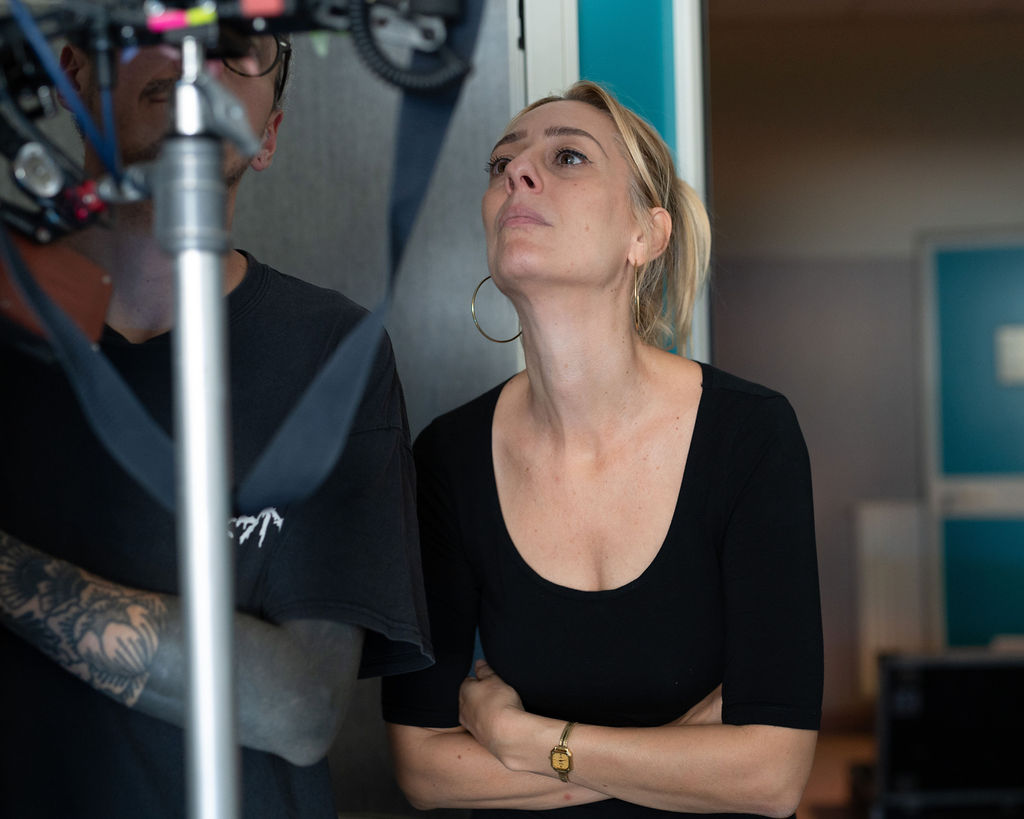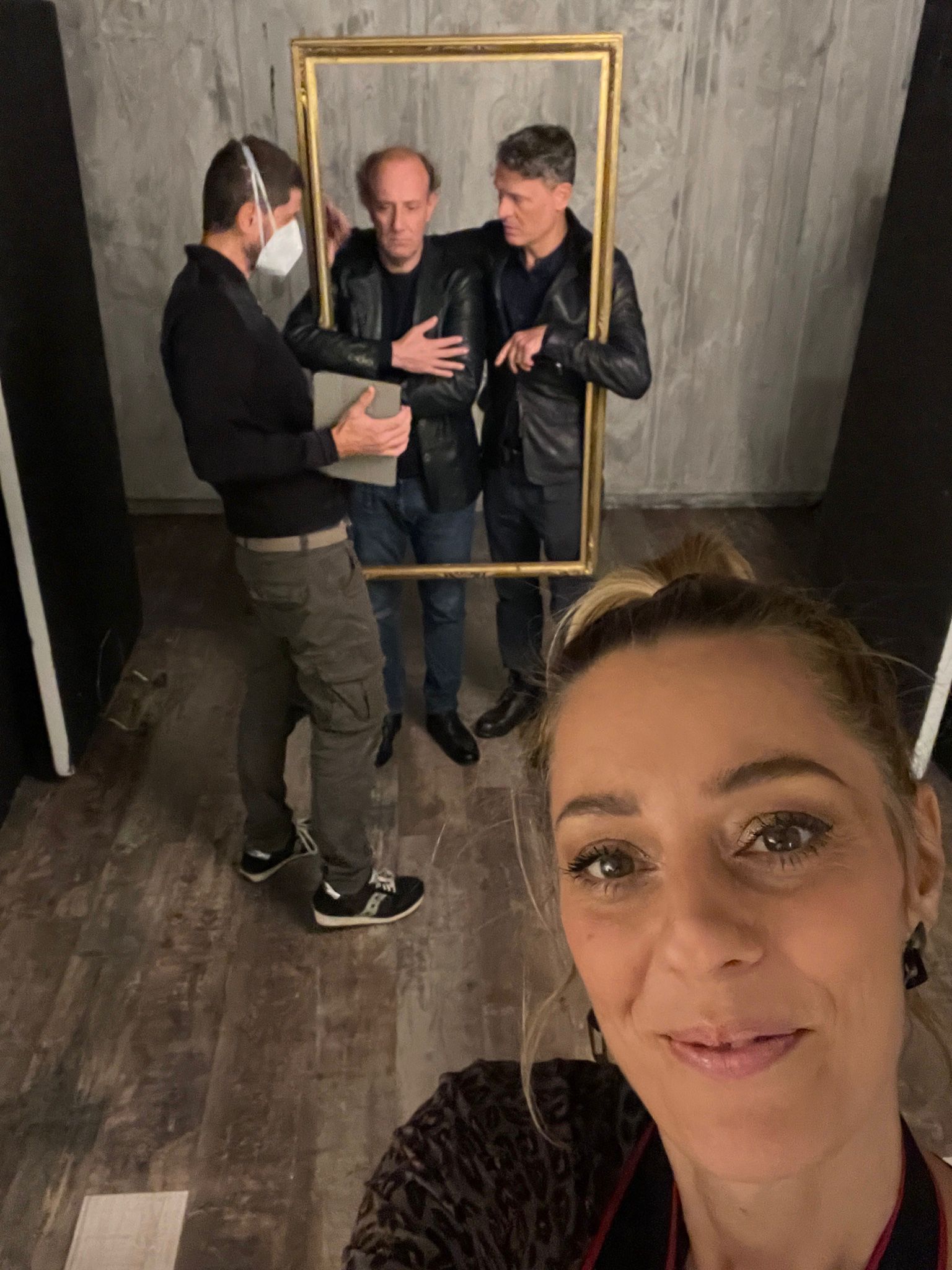WHY HOST A FILM CREW IN THE SPINAL UNIT
The film crew that stayed for a few days at the Spinal Unit is working on a thriller film entitled “Spyne”, written by Paolo Fittipaldi, directed by Anna Antonelli and produced by Creations Factory with the support of Liguria Film Commission where they won the FILSE call for film production.
Although the film is a thriller, it deals with the story of a person with a spinal cord injury, which is a unique opportunity to acquaint the general public with the existence of our department and, more generally, the Spinal Units. The decision to set some of the filming in this setting not only provides visibility for the facility, but also helps to raise awareness of a wide audience on a complex issue such as myelopathy, bringing to the attention of many the rehabilitation challenges that patients face on a daily basis.
Compared to a docu-film devoted entirely to myelopathy, which is aimed primarily at a niche audience consisting mostly of insiders, health professionals, or directly affected people, a genre film such as a thriller has the potential to reach a much wider audience. This implies a greater dissemination of the topic of rehabilitation while not treating the rehabilitation process in a detailed and scientifically unimpeachable manner.
The main advantage of a fictional film is that, because of its captivating plot and the popularity of the actors involved, it can attract the interest of viewers who would otherwise never delve into issues such as spinal cord injury and the rehabilitation journey. This broadening of the catchment area makes it possible to reach people who do not usually attend documentaries or medical information programs. Although the film will not offer an accurate and detailed depiction of the rehabilitation process, it does include scenes showing rehabilitation processes, providing the general public with information on how functional recovery occurs after spinal cord injury.
Another aspect to consider is the emotional impact the film can have. A work of fiction has the ability to create an emotional connection between the audience and the subject matter, thereby increasing awareness and empathy toward people with spinal cord injury. This kind of emotional involvement can have a more lasting effect than a documentary, prompting the viewer to reflect not only on the case narrated in the film, but also on real cases and the difficulties faced by para and quadriplegic people in daily life.
Enhancement of medical and health personnel.
The footage will highlight not only the department itself, but also the work of the professionals working there, showing their commitment and expertise in caring for patients with spinal cord injuries. This can help increase staff pride and improve the image of the entire health facility.
Impulse social inclusion and destigmatization.
Seeing a care setting represented in a cinematic context can help reduce the stigma associated with disability by promoting an inclusive and respectful view of people living with spinal cord injury and other disabilities. This can positively affect how the public perceives these people in daily life.
Increased visibility of the facility in the film and media landscape.
Participation in a film project can position the spinal unit as a focal point for possible future productions, attract educational or documentary projects, and foster collaborations with production companies or organizations interested in promoting health-related issues.
Therapeutic effect on patients’ psyche.
In addition to the distraction and disruption of hospital routine, the presence of a film crew can provide patients with an experience that can relieve the monotony and tension associated with prolonged hospitalization. Curiosity and excitement about an unusual event could even have beneficial effects on patients’ mood and foster a more positive mental attitude during rehabilitation.
Promoting collaboration between art and health care: This initiative demonstrates a synergy between two seemingly distant fields such as art and medicine. Film can be a powerful tool for telling stories of resilience and recovery, and allowing filming in the ward can be seen as a way to support positive life and health narratives.
Having closely followed and monitored , as is my duty, the interactions between the health care team and the film crew, I can testify how an initial transformation in the attitude of the director, actors sound engineers, actors , makeup artists and many other staff (whose names I have yet to learn) already took place as the days went by inside the ward. The level of knowledge of the problem has certainly increased in all of them. This is a foundation stone for the construction of artistic creations ever closer to reality where correct information is married with the creative genius of the artist that makes it pleasant and interesting to “listen ” to the narrative.
Direct contact with the dynamics of a complex context of care and rehabilitation such as the Spinal Unit has aroused curiosity in all of them, which, once satisfied, will determine the basis for artistic creations that are increasingly relevant to reality.
They began to perceive more clearly the daily challenges, emotions and personal stories that are intertwined in such a sensitive environment. This contact contributes to not only professional but also human growth, fostering a narrative that becomes increasingly adherent to the complexities of “rehabilitating the person.”
This builds fertile ground for the creation of artistic works that, while retaining the artist’s creative touch, manage to convey correct and detailed information regarding health issues. This is a fundamental basis for telling authentic stories that can inspire, raise awareness and bring audiences closer to difficult realities, making it “enjoyable” to listen to and understand complex issues.
Moreover, this collaboration can help break the stereotype of a distant and technical medicine, showing it instead as a human journey, where patients are protagonists and their stories become central. Art, in this sense, has the unique ability to humanize medicine, to tell the story of care as a deeply relational act in which emotions, empathy and humanity play a key role.
In conclusion, the initiative to promote collaboration between art and health care is a foundation stone for building an ever truer and deeper narrative of the world of health care. In fact, the fusion of correct information and artistic creativity can educate, excite, and ultimately contribute to a positive change in the social perception of medicine, the sick person, and the treatment process.
I hope I made the right choice in facilitating the Spinal Unit team’s participation in a large-scale film project.
Some additional sacrifice was required of the department’s professionals (doctors, nurses, OSS, physiotherapists, psychologists and administrative staff) who had to shoulder some extra constraints on their actions to make room for the needs of the film crew.
I hope, however, that, if not in the immediate term at least in the medium term, their sacrifice can be repaid by a media buzz that will bring a wide audience to learn about the complex realm of human interactions created within the Spinal Unit, the resilience of patients and their families, the self-sacrifice of professionals and the challenges they face .
Antonino Massone
Chief of Santa Corona Hospital, Pietra Ligure













 And then years go by, more or less 20, and from Friuli, I find myself living in Milan. And it happens one day, that. I find myself in a tiny restaurant in the Bovisa area, that in the table next to mine I see sitting just them: Ale and Franz! Heartbreak!!! I didn’t want to be the one to get up and go ask him for an autograph though…it seemed priori unfashionable 😉
And then years go by, more or less 20, and from Friuli, I find myself living in Milan. And it happens one day, that. I find myself in a tiny restaurant in the Bovisa area, that in the table next to mine I see sitting just them: Ale and Franz! Heartbreak!!! I didn’t want to be the one to get up and go ask him for an autograph though…it seemed priori unfashionable 😉




